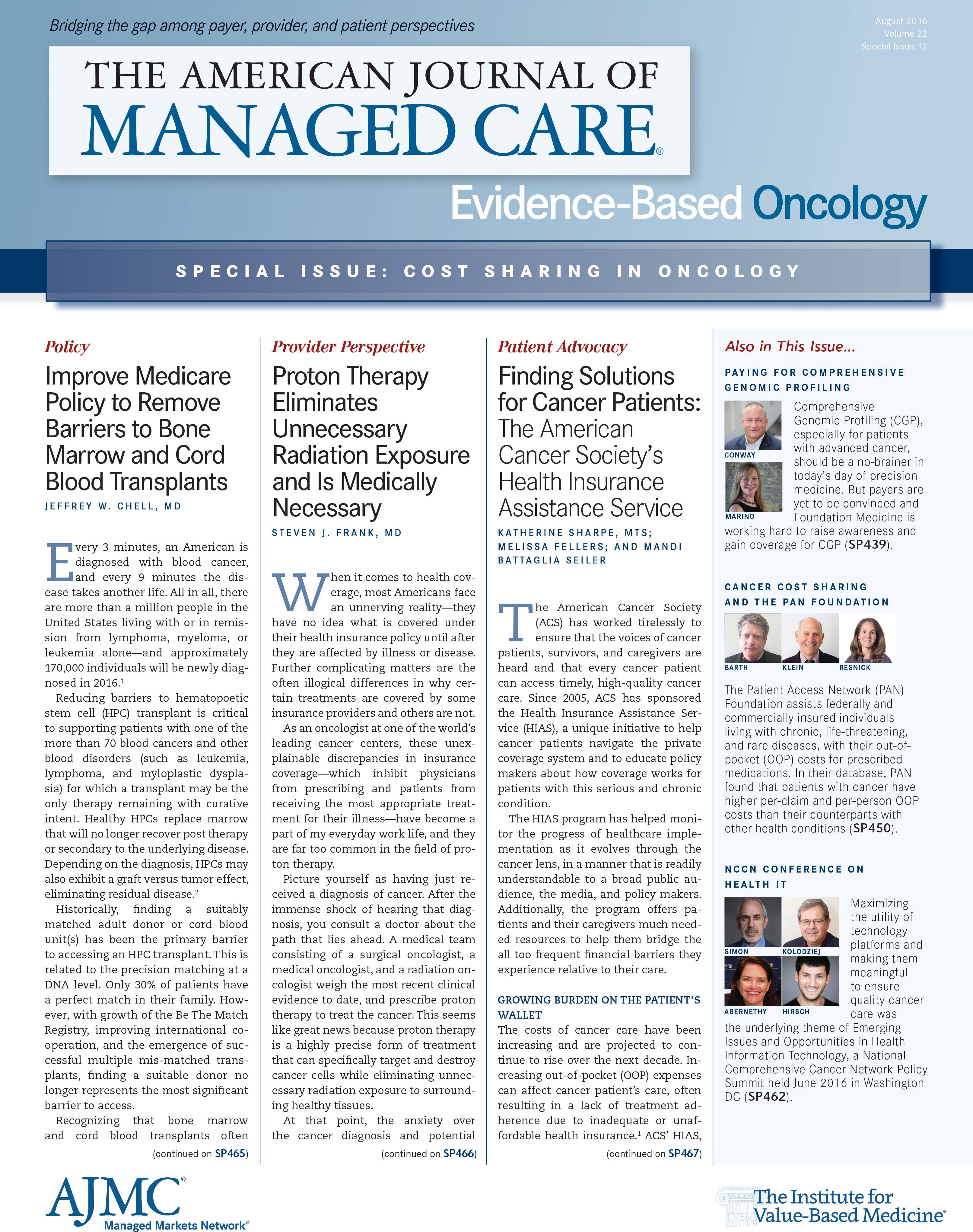Publication
Article
Evidence-Based Oncology
Dissolving Data Silos and Improving Access to Health IT Essential in Oncology Care
Author(s):
At the Emerging Issues and Opportunities in Health Information Technology Policy Summit hosted by the National Comprehensive Cancer Network, on June 27, 2016, an afternoon panel discussed the role of technology and its importance in promoting dissemination of data.
At the Emerging Issues and Opportunities in Health Information Technology Policy Summit hosted by the National Comprehensive Cancer Network, on June 27, 2016, an afternoon panel discussed the role of technology and its importance in promoting dissemination of data. Sharing information, the panelists agreed, can help create a learning system that can improve patient outcomes.
Anthony V. Coletta, chief executive officer of Tandigm Health, a joint venture by Independence Blue Cross and Health Care Partners, said that culture change is a disruptive innovation. “Payers have to be a part of the process,” Coletta argued, “They cannot remain on the periphery.”
“It is important to provide access [to health IT platforms] for community practitioners,” said Michael Pellini, MD, chief executive officer of Foundation Medicine. He pointed out that several tools are currently being developed to do so.
Edith Mitchell, MD, a medical oncologist at Sidney Kimmel Cancer Center at Jefferson Health in Philadelphia, explained that one of the objectives of Cancer Moonshot1 is to simplify trial design and participation. “As a part of Cancer Moonshot, trial design will be simplified, with patients in those specific communities finding access to these trial programs, to allow quicker and efficient validation of these trials. Additionally, breaking down the silos between the various parts of the government” can provide a tremendous push to the project, Mitchell stated.
“Biomarker-driven studies, such as the NCI-MATCH trial,2 can provide early information on a patient’s tumor genetic make-up,” according to Mia A. Levy, MD, PhD, who heads Cancer Health Informatics and Strategy at the Vanderbilt Ingram Cancer Center. This, she believes, will provide a much-needed push toward better personalized care and help rapid learning. “We need this accessible to [patients] around the entire country, unlike right now where it is accessible only in certain geographical pockets.” Levy also indicated that reimbursement for diagnostic testing is another barrier, since not all health plans offer coverage. “The testing needs to be paid for,” she said.
“When we can get this data into the right framework, and when testing becomes more common and accessible, it would be interesting to see whether and how this data can inform care decisions,” said Allen Roeseler, a senior vice president at NantHealth, one of the sister companies floated by Patrick Soon-Shiong, the pioneer of Cancer Moonshot 2020.3
Levy pointed out that clinicians could be overwhelmed with the tsunami of data that they need to collate, and “average clinics may not be adept at handling that amount of information. We need systems or tools that can assimilate and interpret this data to have an impact on clinical decisions,” she said.
The real-time bearing of these platforms and tools cannot be disregarded. “We now have the ability to determine if treatment is effective in a couple of weeks, as opposed to waiting for 10 weeks,” said Mitchell. “So, not only can trials finish sooner, but more importantly, we can change the course of treatment for an individual patient if it’s not effective.”
With Cancer Moonshot, “rather than looking at 1 therapy or technology, we are simultaneously evaluating multiple treatments—so we are breaking silos,” Mitchell added.
Pellini indicated that Foundation Medicine has “not followed the Myriad model because we want those 80% [of] patients in the community to have the ability to know that they have access to their information in the community clinics they visit. That’s not possible if we hold on to that data.” According to Pellini, anything above and beyond what the technology captures can be turned into proprietary information.
“We have collaborated to develop a knowledgebase for cancer and merged it with an individual patient’s clinical information to make this a clinical decision support tool,” said Levy, describing the platform that Vanderbilt has developed in house.
NantHealth, Roeseler said, has created eviti,4 which is currently being used by a large number of oncologists and includes individual genetic profiles. He emphasized that a part of understanding clinical utility of these platforms is speaking to the end users, the clinicians.
Transparency, eliminating silos, and making data readily accessible to those who can use it for the best outcomes was Pellini’s takeaway message. “We need to decentralize the generation of information to improve access to drugs. Additionally, we can reach out to academic centers to decentralize input from these research centers. Technology and data allows us that opportunity,” he said.
EBO
Levy stressed the importance of biomarker-driven research early on in clinical trials to improve efficiency and save time. “We need tools to expand clinical trial access and improve recruitment,” she added, drawing attention to the extremely low rate of adult oncology clinical trial enrollment. REFERENCES
1. Cancer Moonshot. The White House website. https://www.whitehouse.gov/CancerMoonshot. Accessed July 25, 2016.
2. Shaffer A. Largest-ever precision medicine oncology trial ready for launch. The American Journal of Managed Care website. http://www.ajmc.com/journals/evidence-based-oncology/2015/the-american-society-of-clinical-oncologyannual-meeting-2015/largest-ever-precision-medicine-oncology-trial-ready-for-launch. Published July 10, 2015. Accessed July 25, 2016.
3. Dangi-Garimella S. Cancer MoonShot 2020 proposes a collaborative precision cancer care model. The American Journal of Managed Care website. http://www.ajmc.com/journals/evidence-based-oncology/2016/february-2016/cancer-moonshot-2020-proposes-a-collaborative-precision-cancer-care-model. Published February 11, 2016. Accessed July 25, 2016.
4. eviti website. http://www.eviti.com/. Accessed July 25, 2016.







